The Last Warning (1929)
Directed by: Paul Leni
Written by: Alfred A. Cohn, J.G. Hawks, Robert F. Hill, Thomas F. Fallon, Tom Reed
Starring: John Boles, Laura La Plante, Margaret Livingston, Montagu Love
USA
AVAILABLE ON BLU-RAY: 15TH FEBRUARY, from EUREKA ENTERTAINMENT
RUNNING TIME: 72 mins
REVIEWED BY: Dr Lenera
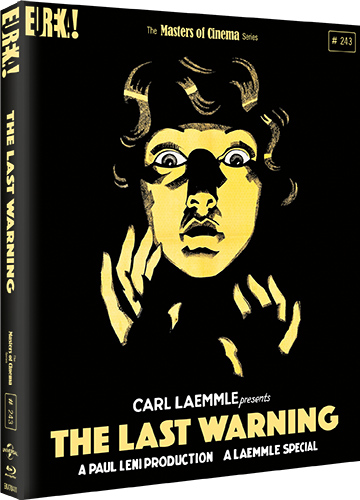
John Woodford, the owner and lead actor of the Woodford Theater on Broadway, is killed in the midst of a performance and his body disappears. Several drops of chloroform are found dripping onto the stage, and talk of a love triangle between Woodford and two cast members circulates as a possible motive for his death, but nobody is arrested, Five years after the theatre’s closure, producer Mike Brody decides to staging the play with the remaining cast which would involve re-enacting the murder. During rehearsals in the abandoned theater, strange occurrences begin to plague the cast and crew. It seems that a certain ghost doesn’t want the play to go ahead….
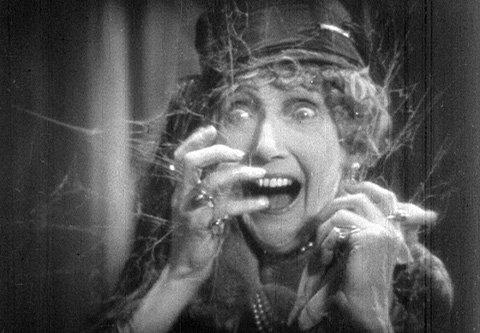
After the poetic, poignant yet hugely entertaining The Man Who Laughs with that incredible performance from Conrad Veidt as the man permanently disfigured with a huge grin on his face, I was eager to check out more from its director Paul Leni who on the evidence of this film was a fine story teller who had a real command of the medium. Soon after I got to see his version of The Cat And The Canary, a comedic old dark house mystery [these were hugely popular at the time], though then got sidetracked. However, Eureka Entertainment have come to the rescue with The Last Warning, which was the director’s last film. It’s quite similar to The Cat And The Canary, with some repetition of devices, situations and even characters, but the result is still a diverting mystery thriller with touches of horror which unashamedly revels in the cliches of a form which was soon to be largely replaced by horror of a full-on kind, much of it from the same studio Universal, beginning with Dracula which kick-started the first horror cycle. It titters on the edge of being a send-up in what is quite a skillfully achieved balancing act. I’ll say right now so I can get it out of the way; it’s not the film that The Man Who Laughs is. However, it’s by far more stylishly filmed; in fact some of the things like Leni and his cinematographer Hal Mohr [who matches his great work in The Phantom Of The Opera] do with the camera are really audacious [especially seeing how big cameras were then], while Leni is working overtime to make things look interesting; this is a film where even character entrances are made into tiny set pieces. This more than makes up for some things many today will find goofy, such as the terrified reactions to letters that claim to be have been sent by a ghost. I would think that most people would have laughed it this even back in 1929, but then as I said this film does seem to be a borderline send-up without actually becoming one, so I should probably give some things a pass.
It was based on the 1922 play of the same name by Thomas F. Fallon; the play was in turn based on the story House of Fear by Wadsworth Camp which was sometimes retitled Backstage Phantom. For the stage, some elements of the story were altered. The most notable example of this was the fact that in the book the first act taking place fourty years before the rest of the tale with very few characters coming back to their old play; this was changed to five years for the stage so that much of the cast and crew returned. The reason for the killings was also tweaked because the original explanation referred to World War One. The Cat And The Canary was a big success in 1927, so it was no wonder that Universal tried to repeat its impact and popularity, as well as the ongoing popularity of this kind of story for both stage and screen, though for some reason it was given a lower budget. As well as Leni, Laura La Plante, who’d previously starred in the earlier film, was given top-billing in her role as Doris Terry, even though she had far less screen time. Shooting took place on the same theatre set that The Phantom Of The Opera had haunted, and the influence of that film can be felt on this one. One of the last major silent films, it was released in a silent version but also a “part-talkie” Movietone version with two minute’s worth of synch-sound footage added, as well as screams, cries, and other sound effects. This version met with a poor critical reception and is now lost. The film still did well at the box office, but seemed to almost disappear for many decades. It was Leni’s final film before his career was cut short by his death of blood poisoning at the age of 43 only a few months after it premiered. The Last Warning was re-made in 1939 under the title The House of Fear [not the Sherlock Holmes movie of that name]
The first title card announces that we’re in Broadway, the writing appropriately looking like neon, and then we get an astounding little montage, virtually repeated later, of theatreland, with several shots of streets combined on screen while dancing girls [and a man in ‘blackface’] flutter across the screen and almost look like they’re walking in the air until they multiply and the picture becomes positively kaleidoscopic. It’s a real attention-grabber of an opening. Now we cut to turmoil in one of the theatres, because somebody has just died on stage. Jeffries, the main investigator from the law, asks how this happened, and we get a flashback to it, shown unusually with a long distance shot of the stage where we can see John Woodwood backing into a corner of the stage where his character is supposed to be killed, before we get a cut to black and then reopen on John falling down dead. Jeffries decides to interview some of the cast and crew and learns of an argument between star Richard Quayle and co-star Doris Terry, an argument that we never actually learn was about, though we can guess that the two are romantically involved and that the row may have had something to do with the fact that Doris had two other admirers, her dressing room being filled with signed photographs of themselves, flowers and protestations of love. One was John, and the other was another performer in the play named Harvey Carleton. So we have two possible suspects here but no real evidence of either of them having done it, so there are no arrests. This beginning section is concluded in a very inventive fashion. Against a backdrop of New York City, we see, as was normal for the time, newspaper headlines, but this time they stand up from being flat and increase in number so much that they fill the screen before the ink on them looks like it’s running so the paper becomes blurry. Even if the story hasn’t grabbed you, the visual innovation certainly will have done.
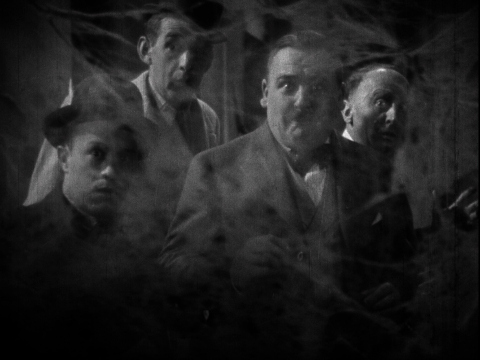
We rejoin the theatre five years later, and it’s now in a very rundown state. People are coming back to perform again, even if the new producer Mike Brody’s plan to re-commence the same play that ended so badly five years before isn’t loved by everywhere. A lot of time is spent introducing or re-introducing characters, sometimes in rather memorable ways. Of course most people knows each other, though Mike has insisted on bringing in some new talent in the form of Evalynda Hendon, and the camera fixates on her legs in what must be one of the first examples of subjective filming for a voyeuristic purpose. Evalynda actually likes it when the enormously older and very rich Josiah Bunce takes an instant shine to her, so we’re immediately intrigued by her. And we enjoy the general interaction of everyone which continually has an edge to it despite the would-be comic relief provided by Torben Meyer as Gene. I say “would-be”, because a person whose funniness revolves entirely around him or her being easily scared has rarely amused me personally, but of course others may feel differently and the character type was a continual ingredient in films of the time. However, I did chuckle at Tommy Wall the electrician twice pointing out someone to his assistant Buddy that he killed John, and was a tad disappointed that it failed to become a running gag. And there’s an amusing elderly lady character played by Carrie Daumery named Barbara Morgan who’s first seen stepping over a spider’s web from the point of view from the floor, then materialising out of darkness on the left hand side of the screen. She reminded me of Una O’ Connor’s turns in The Invisible Man and Bride Of Frankenstein – which makes sense because director James Whale also seemed to borrow a few shots from The Last Warning for The Old Dark House. And look, there’s Frankenstein‘s bland romantic lead John Boles as another bland romantic lead.
The proceedings do become more serious [yet without losing their tone of knowingness] as things get strange for our poor bunch of people stuck in this creepy theatre. Letters from the ghost of John warning them not to re-open the theatre and restage the play. Ominous noises. Falling scenery. A fire. The theft of a purse. Glimpses of John. Somebody even disappears from the stage – and then reappears not knowing what happened. The pace speeds up while we wonder who the culprit could be – and it could almost be anyone, seeing as most of the characters seem to be suspicious. There are a few surprising eerie moments that would have certainly had 1929 audiences shuddering or even screaming, like a sighting of the ghost from a distance high up in one of the boxes, and the masked killer appearing suddenly from the top of the frame. The mask itself is quite unsettling, clearly having been designed to scare. Other devices like clawing hands superimposed on the action perhaps don’t come off nearly as well today, and the final act seems rushed in this 72-minute film which begins to adopt a feel akin to that of a giallo or slasher movie several decades before either form had been born, but then cuts things rather short. Still, we do get a pretty athletic climax with much swinging about, and some revelations which generally serve the movie okay. We’re left with a few questions, but then I think that tying things up were way down the list for Leni and his four screenwriters Alfred A. Cohn, J. G. Hawks, Robert F. Hill and Tom Reed. I think that one has to understand that they were simply sticking to expected conventions that had been part and parcel of this kind of entertainment since the first film version of The Bat, albeit from a slightly wry viewpoint.
Performances aren’t especially mannered except for a bit of the expected comedic mugging, while performers often seem to have been chosen for their interesting, slightly grotesque faces which are given plenty of closeups. Leni and Mohr revels in shadows, cobwebs, tilted angles and confined spaces backed up by some typically fine art direction from Charles D. Hall, one of the top men in his field at the time. The front of the theatre looks like a solemn human face. And Boy does the camera move and go places. Afterwards, movies became very static for a while due to the advent of sounds, and one wonders if Leni saw the way that things were going seeing as he tries almost anything. Leni’s favourite thing is to have a medium shot and then move the camera in to show something important before moving it back out to let the action play out, but then he also shows us the viewpoint of somebody jumping off the top of the stage and plummeting to the ground, the viewpoint of somebody swinging on a rope, and distorted perspectives. When somebody collapses, they collapse right in front of the camera. Sometimes the film even speeds up. And the title cards often expand, contract, or go in and out of focus, depending on the circumstances of the story or the mood of the characters. The Last Warning is undeniably hugely dated but often in a really good way and should provide plenty of fun for those interested in really vintage horror films, even if there’s no supernatural stuff. As I finish the main part of this review, I wonder how things would have been if Leni hadn’t died so soon. He’d been chosen to inaugurate Universal’s monster series with Dracula, and perhaps he would have got Frankenstein too. There aren’t many ways in which Frankenstein could be improved, but a Leni Dracula might have been quite something.
SPECIAL FEATURES
Limited Edition O-Card slipcase [2000 copies]
1080p presentation on Blu-ray from Universal’s 4K restoration, available for the first time ever on home video in the UK
Previously out on Region ‘A’ from Flicker Alley, Eureka’s release probably uses the same restoration but gives it a new encode. The first couple of minutes look quite rough, but the majority of the film looks pretty fine with the large amount of darkness posing no problems, Every now and again a more faded and/or scratchy shot appears, but, like many films of this era, the restorers had to piece together the complete movie from more than one source. Viewers experienced with films this old should have no complaints. Some versions of this movie are tinted, but Eureka’s release is purely black and white like Flicker Alley’s.
Score by composer Arthur Barrow
Sadly the original score is lost, but it’s not that sad because Barrow’s score is very good indeed, diversifying between dramatics, comedy, jazz and even exaggerated sound effects yet with well structured and with an ominous main theme threaded throughout.
Brand new audio commentary with horror and fantasy authors Stephen Jones and Kim Newman
Eureka lose two small extras from the Flicker Alley, but I think we can say that their inclusion of a talk track makes there’s the better release, especially when it’s by Stephen Jones and Kim Newman. This duo have been giving us great audio commentaries for some time now, and this track is well up to their usual standards; informative, observant and oozing the great love of movies that these two possess. While there obviously isn’t much production information available [something that I also found], we get much appreciation while always being away of the conventions of the time, and chat about the early evolution of the horror genre, while this film is adroitly described as where German expressionism [German cinema widely considered to be the best at the time] and American commercialism [American cinema the most popular] meet. Above all, there’s just so much enthusiasm.
Paul Leni and “The Last Warning” – video essay by film historian and author John Soister on Leni’s final film [10 mins]
This Flicker Alley featurette probably couldn’t be too long because of the lack of ‘making of’ information, and little of it will be new if you’ve heard the commentary, but we do get a good picture the state of cinema at the time where films were often held up so that cinemas could have sound equipment installed.
Rare stills gallery
A collector’s booklet featuring a new essay by Philip Kemp and a short essay by composer Arthur Barrow on his score for the film
Check out a good example of a type of film that was the closest to American horror cinema before the genre had really been invented. Recommended!






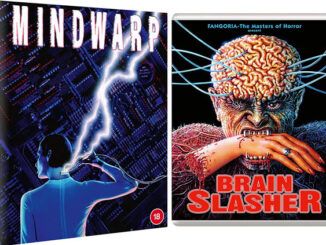
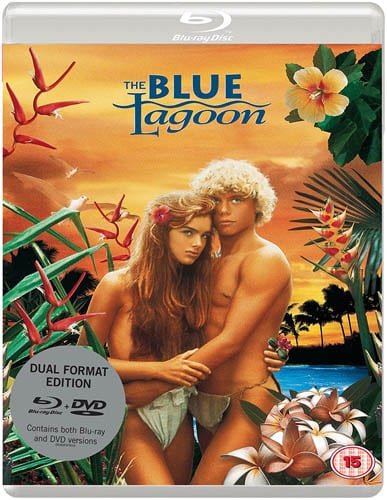
Be the first to comment